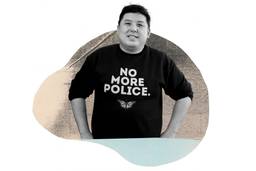Hurricane Katrina is being touted as a turning point in American politics. Much has also been made of the press’ outrage over the abandonment of New Orleans. But will journalists’ rediscovered mission to question authority continue?
As I noted last month, the press had already shifted into a much more querulous and combative post-post-9/11 mode that the president, who claims not to read newspapers, seems to have failed to notice. Now we can confidently refer to the post-Katrina journalism era. When the levees broke, with Bush playing air guitar, the press was waiting for him. (Not all the press, of course. When Bush made his infamous comment on “Good Morning America,” “I don’t think anyone anticipated the breach of the levees,” Diane Sawyer didn’t bat an eye.)
One notable facet of Katrina coverage was the particular relationship that emerged between what progressive bloggers were reporting and what the mainstream press covered. For much of the Bush regime, progressives have been exasperated that stories that seemed hot – the 2004 election irregularities in Ohio, the Downing Street memo, to name two – circulated widely online but were either ignored or buried in the mainstream press.
This had begun to shift in recent months, especially with Cindy Sheehan’s media-savvy protest in Crawford. But with Katrina, bloggers, online magazines like Salon, and listservs swiftly came to serve as legitimate sources – fact finders, investigative reporters and news frame debunkers – that the print and electronic media drew from and responded to, sometimes within 24 hours. At the same time, online sources also instantly picked up mainstream news items critical of the government’s response. Print stories that a national audience might not normally see found a huge audience as millions hit their “send” and “forward” buttons.
On Monday, August 29, as the levees broke and the flooding began, the press went into its usual disaster-mode reporting. As early as the next day, the AP began reporting about massive looting. By Wednesday, black people as looters was the main story on Fox, and this news frame circulated in other media as well, as did still-unsubstantiated stories about rapes and murders.
Despite the damage done by this racist frame, it could not hold. Two photos from Yahoo News soon rocketed through cyberspace, revealing a bias in reporting about hurricane victims. One from the AP showed a black person wading through the flood captioned “looting,” the other from Agence France Presse of whites in the flood waters captioned “finding food.” Reporters on the scene moved to undermine the looting talk. NBC’s Brian Williams noted as early as August 30, “We see what can happen when people have nothing.” CNN’s Anderson Cooper said, “I wouldn’t call it looting. What I have seen is desperate people kind of wandering around.” By September 1, the story had shifted, with a new emphasis on the victims being disproportionately poor and black. The rapper Kanye West put it simply on NBC’s live Concert for Hurricane Relief on September 2: “George Bush doesn’t care about black people.”
Rich background material also flashed quickly across the newly empowered echo chamber. Within two days of the disaster, an August 31 story in Editor & Publisher, Agence France Presse, and the online magazine Counterpunch all cited the now well-known 2004 – 2005 exposé by the New Orleans Times-Picayune. By September 2, the same story was in the Washington Post, the New York Times and the Los Angeles Times. Sidney Blumenthal, shrewdly anticipating the Bush denials, broke the same story on Salon under the prescient headline “No one can say they didn’t see it coming.”
Stories that would not have gotten play pre-Katrina now did. On September 1, media critic Mark Crispin Miller’s listserv noted that FEMA’s Web site listed Pat Robertson’s “Operation Blessing” charity second only to the Red Cross. By September 6, the Daily News had picked up the story, and ABC followed with a September 9 exposé of Operation Blessing’s dubious practices. Even the presidential mother was not off limits. In her tour of the Astrodome, the former First Lady chuckled that the setup was “working very well” for underprivileged hurricane victims – a remark captured on audio by NPR’s “Marketplace” and sent zooming around the web by Editor & Publisher and AMERICAblog. Amazingly, the remark appeared in the New York Times the next day in its own special little box, and she became the subject of various withering political cartoons around the country.
Katrina was a perfect storm journalistically, but will such coverage be restricted to this particular horrific event? Or will the bridges between print, electronic and online news remain intact? The reporting of the national news organizations will answer the question. But a brief period in which the country’s failed war on poverty, its institutional racism and the utter bankruptcy of a “CEO presidency” were all lead stories is testimony to what can happen when those at the margins of the mainstream media (and of our country) finally get the podium they deserve.

I hope you found this article important. Before you leave, I want to ask you to consider supporting our work with a donation. In These Times needs readers like you to help sustain our mission. We don’t depend on—or want—corporate advertising or deep-pocketed billionaires to fund our journalism. We’re supported by you, the reader, so we can focus on covering the issues that matter most to the progressive movement without fear or compromise.
Our work isn’t hidden behind a paywall because of people like you who support our journalism. We want to keep it that way. If you value the work we do and the movements we cover, please consider donating to In These Times.
Susan J. Douglas is a professor of communications at the University of Michigan and a senior editor at In These Times. She is the author of In Our Prime: How Older Women Are Reinventing the Road Ahead.








